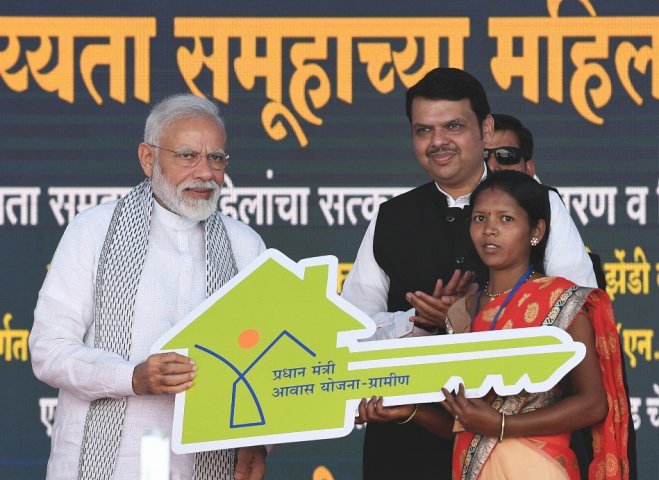Infrastructure development is a key driver of economic growth, social mobility, and quality of life. Investments in transportation, housing, and public services enhance accessibility, reduce inequalities, and create economic opportunities in both urban and rural areas.
Looking from a gender-sensitive lens, infrastructure development has both generic and specific implications, particularly for women, because of existing mobility constraints, safety concerns, and socio-cultural barriers.
In rural India, housing conditions, poor road connectivity, and unreliable transport are often considered as being directly connected to limiting women’s access to education, healthcare, and employment. Meanwhile, despite better infrastructure, challenges such as long commuting times, overcrowded public transport, poor last-mile connectivity, and housing unaffordability near workplaces remain key constraints for urban areas.
With recent infrastructure transformations across urban and rural regions, this outlook is now changing. Over the years, the response to these developments has demonstrated how infrastructure enables accessibility, empowerment, and economic growth for women.
Opening Opportunities Through ‘Housing For All’
The Pradhan Mantri Awas Yojana (PMAY) was launched in 2015 under the vision of Prime Minister Narendra Modi to achieve ‘Housing for All.’ Housing remains a key determinant of social mobility and overall quality of life. For women, the shift from slums and informal housing to secure and stable housing contributes largely to their growth.
According to recent data, most houses under the scheme are registered in women’s names. As of 2025, 39,82,764 houses have been sanctioned under the PMAY-Gramin, with 74 percent under sole or joint female ownership.
The goal of creating slum-free cities through various PMAY models has shown success. Based on primary insights, the Affordable Rental Housing Scheme (ARHC) under PMAY has majorly improved the lives of women from slum-dwelling families in Chandigarh. In slums, they faced challenges with irregular access to water, electricity, and sanitation while ensuring the safety of their homes and children. This lack of security and basic amenities often restricted their mobility, forcing them to stay home.
The transition to permanent housing allowed these women to shift focus beyond daily survival to engaging in work and social activities. For many, access to secure premises, electricity, and water supply has freed them from constant household struggles and allowed them to pursue employment opportunities.
Many skilled women willing to contribute to their households have started working outside, as they can now manage household needs well and leave their kids in the secured premises. Some women have also initiated home-based economic activities such as tailoring, kitchen gardening, and handicrafts, using the improved space and security in their new homes. Additionally, children now have access to safe play areas and better infrastructure, which has particularly benefited girls by increasing their mobility and access to education. A detailed first-hand experience can be read here and here.
A similar transformation also progressed in Solapur, Maharashtra, where the largest mass housing project under PMAY has provided nearly 30,000 homes to the poor. Notably, 90 percent of these homes are registered in the names of women, primarily beedi kargaar (tobacco workers) and daily wage workers. This community-driven initiative was led by women with support from the state, private entities, and the Centre’s PMAY, making this a successful project.
For decades, these women faced severe challenges—no regular water supply with limited water availability only once every 5-6 days, no private toilets (which forced the women to use public restrooms), and unsafe surroundings for kids. With the pucca houses, these women are excited for better opportunities for work and a brighter future for their families, with the supporting infrastructure for skill training and education within the housing complex. Such initiatives have played a pivotal role in supporting women to come out of dismal living in slums and own quality homes, ensuring proper living standards.
Improving Women’s Transit Experience
Rural Road Infrastructure
Several studies have examined the impact of rural connectivity on development. The Pradhan Mantri Gram Sadak Yojana (PMGSY), launched by the Indian government in 2000, aims to reduce infrastructure disparities between rural and urban areas by constructing all-weather roads in rural habitations. As of December 2024, 7,69,51 km of roads and 9,199 bridges have been completed. In September 2024, the Union Cabinet approved PMGSY-IV, which will fund the construction of 62,500 km of roads to connect 25,000 unlinked habitations.
Since 2014, the government has involved Women Self-Help Groups and women in Panchayati Raj Institutions in drafting rural road project reports. A recent study specifically highlights its effects on women through various indicators. Data from the India Human Development Survey (2011–12) shows that over 30% of women face mobility restrictions.
The study (Nandwani and Roychowdhury 2024) found that rural road construction enhanced women’s empowerment by reducing mobility restrictions, allowing women more time for productive activities, and expanding access to education and employment beyond agriculture. PMGSY roads improved access to markets and job opportunities beyond local habitations. As a result, the share of people with primary employment outside their habitation increased by 35% since 2009. In education, the expansion of roads contributed to the rise in the enrollment of girls.
Metro Transit Systems For Indian Cities
Over the last decade, India has substantially invested in metro rail infrastructure. With the goals of reducing urban congestion and transport emissions and providing a reliable and faster transit experience, India’s metro network today covers 22 cities. India is all set to expand its metro rail network to approximately 2,000 km over the next seven years, with an annual growth rate of 175–200 km, an increase from the previous 20–25 km per year.
The largest network, the Delhi Metro, started in 2002 and currently spans nearly 400 km across Delhi and the NCR, becoming an essential part of the city’s transportation framework. The Delhi Metro has profoundly impacted women’s travel experiences, offering a safer and more reliable alternative to other public transit options. It has made a big difference by providing special facilities for women to cater to key challenges—commute time alongside household duties, ensuring affordable and high-quality travel, providing well-monitored stations for safety, maintaining clean spaces, reserving seats and coaches for women, and making travel between home and work easier.
The metro network and supporting infrastructure have met these key criteria while ensuring a gender-sensitive travel experience. This has enabled women of all age groups to participate in various sectors. Until 2014–2015, bus ridership in the city was two to three times higher than metro ridership. However, with the metro’s rapid expansion and improved coverage, this gap has significantly narrowed, making it a more accessible and preferred mode of transport.
Thus, while infrastructure development contributes to diverse aspects of progress, bringing together elements of economic growth, accessibility, and social equity—incorporating gender-based reflections—is crucial to measure the impacts of these developments.
The views and opinions expressed here belong solely to the author and do not reflect the views of BlueKraft Digital Foundation.







